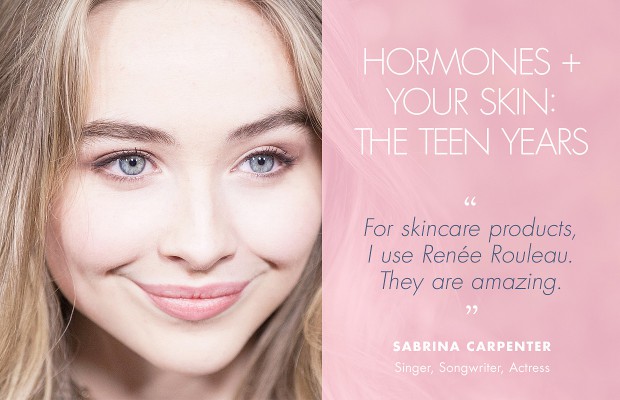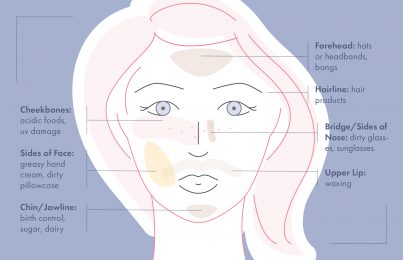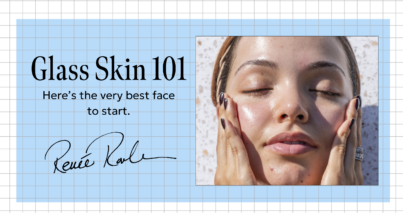Updated 3/20/19. From ages 13-19, hormones play a big part in a teenager’s skin—and emotions. (As you parents know all too well!) The fluctuating hormones known as androgens can aggravate your skin by increasing oil production which causes acne to appear. These breakouts can be very severe while for others, they can be fairly mild.
- How is the skin affected by hormones during your teen years?
- Tips to manage skin breakouts during ages 13-19
- Use a lightweight lotion
- Perform weekly mask treatments
- Get deep pore cleansing facials, as needed
- Try limiting dairy in your diet if you’re prone to cystic breakouts
- Choose acne spot treatments for the type of breakouts you get
- Consider birth control pills
- Learn the difference between an esthetician and a dermatologist
In this post, I’ll be explaining in further detail as to how these hormones can affect your skin during these years, as well as my expert tips for how to manage all that is going on so your blemish activity can be kept to a minimum. Here goes!
How is the skin affected by hormones during your teen years?
- Progesterone (regulates sleep, immunity and brain function)
- Estrogen (supports collagen production which is responsible for keeping the skin plump and free of wrinkles)
- Testosterone (regulates oil glands and hair growth)
- DHEA (protects against oxidative stress which is an important function in preventative skin aging)
- Human growth hormone (supports skin’s elasticity and muscle)
Just prior to your teen years is the prepubescent years (ages 9-12). Hormones are not really influencing your skin other than the start of a few blackheads on the nose. Come age 13 and beyond, the skin can change fast and it usually starts in the t-zone. Many teens feel like breakouts just come out of nowhere—and they kind of do! Enter hormones.
Male hormones, known as androgens, are produced by the testes in males and by the adrenal glands in females. Androgen is an endocrine hormone that flows directly into the bloodstream and is known to be a stimulant for oil activity in your skin by biochemically causing the sebaceous gland’s cells to start producing sebum (oil). Due to a genetic trait, your sebum may be thicker causing your follicular walls to swell, making it difficult for oxygen to penetrate the follicle. Since bacteria have a hard time thriving in oxygen, the lack of it sets up the perfect environment for red, inflamed blemishes to appear. You can read more about why and how breakouts form.
Generally, boys will experience more acne during their teen years than girls due to large amounts of testosterone that can also over-stimulate the sebaceous glands. Girls will experience fewer breakouts during their teen years but are more likely to have breakouts well beyond their teen years since they have a monthly cycle of shifting hormonal levels. (Breakouts can go well into their 40s and even beyond. No fun!)
Tips to manage skin breakouts during ages 13-19
Wash with a gentle, anti-bacterial cleanser morning and night
Since the skin of a teen tends to be quite sensitive, you’ll want to keep your products on the non-drying side. (I realize this is very opposite of what is typically promoted out there.) Traditional acne cleansers use harsh detergents which strip the skin and further set off inflammation. Instead, I recommend that you use a gentler cleanser with an ingredient called salicylic acid. This is a keratolytic beta hydroxy acid (BHA) famous for its ability to exfoliate the skin, reduce acne-causing bacteria and oil within the pore lining, and lessen post-breakout redness and discoloration—all without causing irritation.
For teens with highly active hormonal skin activity, you really need to have the perfect, non-drying cleansing and deep pore cleansing experience. I recommend AHA/BHA Blemish Control Cleanser. (Fun fact! It was awarded ‘The Best of Beauty’ award for “Best Cleanser for Oily Problem Skin” by Allure Magazine.) Washing with this both morning and evening will help to control stubborn breakouts without irritating your young and sensitive complexion.
Use an alcohol-free toner to keep your skin cells hydrated
After cleansing, I always suggest that you wipe your skin with an alcohol-free toner to remove excess cleanser residue and impurities from tap water, as well as to give instant hydration. For young skins that do produce oil, the main requirement is water to keep the skin in a healthy state. Skin cells are like fish and need water to live so by using a toner, (left damp on the skin after cleansing and sealed in with a light lotion), it can dramatically increase the skin’s integrity to keep it in balance. Post-cleansing, I recommend Balancing Skin Tonic because it’s effective for pore clearing and managing oil. Skin types #1, #2, #3 and #4 are generally types that a teen will identify with.
Wear sunscreen to protect the skin and help fade post-breakout scars
I realize that the least of most teenagers concern is to prevent damage from the sun. I’m sure if you’re reading this, your biggest concern is about controlling breakouts but it’s important to know that sunscreen can actually help with acne.
When choosing a sunscreen, look for one with zinc oxide. This ingredient can be very anti-inflammatory when it’s on the skin. This makes it ideal for calming red, inflamed blemishes. (Zinc oxide is actually the main ingredient used in diaper rash creams for its visible soothing and healing properties.)
This may come as a surprise but sunscreen can help with the fading process of discoloration left behind from blemishes. Acne scars result from inflammation of the dermis layer of the skin. This inflammation then triggers pigment cells, which result in the appearance of red or purple discoloration. When your skin is exposed to UV daylight (in spring, summer, fall and even in winter), this keeps pigment cells awake and prevents your blemish scar from fading as easily. Wearing a zinc oxide-based, lightweight, non-pore clogging sunscreen protects damaged cells so they can properly heal and recover so the skin can get even-toned much faster. For all of my teen clients, I recommend Weightless Protection SPF 30 to be worn daily as your moisturizer. For touch-ups, like for after-school sports, you can keep a mineral-based sunscreen powder in your bag and quickly dust it on your face as needed.
Simply put, sunscreen plays an important role for acne-prone skin types and if you want your scars to go away as quickly as possible, you must wear it every day of the year. You’re also preventing the appearance of lines and wrinkles as well as potentially warding off skin cancer, which will definitely become more of a priority for you down the road.
Read more tips for fading acne scarring.
Use a lightweight lotion
I can’t say enough about how hydration, from a water-based standpoint, is key to keeping young skin in a healthy balance but adding a lot of oil is not always the best choice. Since your skin has it already built right in, and at this stage in your life, it’s flowing at a rapid rate, you don’t need to add much more. Your skin does need water so using a lightweight lotion with a high water/low oil ratio will give your skin exactly what it needs. Make sure your lotion has soothing ingredients and your skin will be perfectly in balance so it can act in a healthy way.
Perform weekly mask treatments
For a teen who is dealing with clogged pores and breakouts due to hormones, you really need to put in some extra effort to get your skin clear. Cleansing, toning, and moisturizing is usually not enough. Your skin requires extra benefits above and beyond what those products will deliver to increase the results. Once a week, it’s very beneficial to use a deep pore cleansing and disinfecting treatment.
Get deep pore cleansing facials, as needed
This is a very important one. When it comes to clogged pores and breakouts, skin care products can only do so much. What is missing is the need for manual extractions to remove blocked pores and bumps with professional extractions. Teens are not always as diligent about their home care routine (especially boys) so professional skin treatments can really give your skin the attention it needs to keep it looking its best. Plus, if you’re a Mom reading this, you know how challenging it can be to get your child to listen to what you might be telling them. Often times, hearing it from a skin professional will be more impactful.
Try limiting dairy in your diet if you’re prone to cystic breakouts
Since most dairy cows are given growth hormones, the consumption of milk, cheese and yogurt become factors that influence endogenous hormones and mimic the hormones that trigger oil production in the skin to ignite the acne process. Consider eliminating all dairy for two weeks to determine if this is the cause of your breakout activity—especially cystic acne.
As for other foods, there is some talk that meat and sugar may also be contributors, so keep that in mind, however, dairy is the one food group that I know can dramatically improve the skin in certain teens when it’s eliminated or greatly reduced. Read more about cystic acne and dairy.
Choose acne spot treatments for the type of breakouts you get
All breakouts are not equal nor is every blemish spot treatment. For example, if you experience deep, painful cystic bumps, applying a traditional drying spot treatment will only leave the surface of the skin a flaky, dry mess while leaving the active bump underneath. It’s so important that you understand there is a life cycle for each type of blemish. I highly recommend that you read my step-by-step instructions for what to do the moment a blemish appears to get it to go away fast with minimal scarring. Please read it several times so you can truly understand how the natural healing process works. This information has been very insightful for my acne clients to help them learn why they are often making things much worse by using the wrong type of blemish at the incorrect stage of the healing process. Simply put, you always want to work in sync with Mother Nature.
Consider birth control pills
Birth control pills can have a positive effect on breakouts for young girls, so it’s worth exploring this option if your doctor confirms your breakouts are hormone related and all other efforts to reduce acne have not quite helped.
Some examples of FDA-approved birth control pills that seem to lessen breakouts include Ortho Tri Cyclen, Yaz, and Estrostep; but your doctor can help to determine the best course of action. This is a great post that discusses the various birth control methods and how they might affect the skin.
Learn the difference between an esthetician and a dermatologist
Typically teenagers may gravitate towards seeing a dermatologist the minute hormonal blemishes start to appear, but it’s important to know that doctors will typically take you down a path of oral and topical prescription medication. While this can be beneficial, some prescriptions can come with unwanted side effects. Seeing an esthetician will give you a less invasive approach to improving your acne. Here are the main differences between a dermatologist and an esthetician.
Not all teenagers will experience acne since it’s largely due to genetics, so do consider yourself lucky if you make it out of your teen years pimple-free. However, it doesn’t mean you won’t experience breakouts later on in your adult years since hormones, diet, and lifestyle will always play a part in how the skin behaves.
Here are 11 common causes of acne that you should find helpful.
Read how hormones affect the skin in the 20s, 30s, 40s, 50s, and 60s.
Celebrity Esthetician & Skincare Expert
As an esthetician trained in cosmetic chemistry, Renée Rouleau has spent 35 years researching skin, educating her audience, and building an award-winning line of products. Her hands-on experience as an esthetician and trusted skin care expert has created a real-world solution — products that are formulated for nine different types of skin so your face will get exactly what it needs to look and feel its best. Trusted by celebrities, editors, bloggers, and skincare obsessives around the globe, her vast real-world knowledge and constant research are why Marie Claire calls her “the most passionate skin practitioner we know.”



